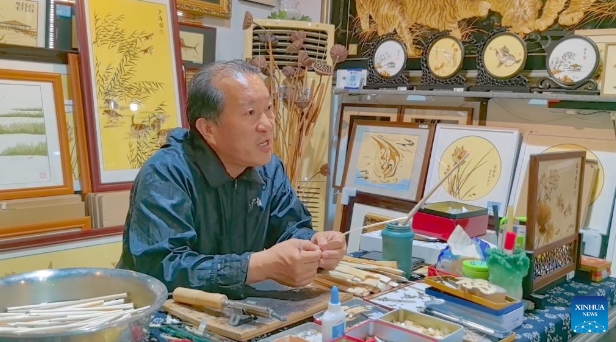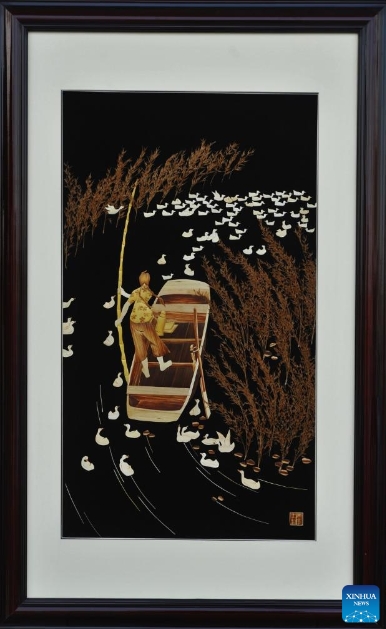Transformation of the humble reed in China's Xiong'an

This cellphone photo taken on May 9, 2024 shows Yang Bingjun speaking during an interview with Xinhua at his reed painting art gallery in Xiong'an New Area, north China's Hebei Province. (Xinhua/Zhang Can)
In the eyes of 58-year-old Yang Bingjun, the common reed can be woven not only into producing mundane necessities, but also transformed into appealing artworks exhibited in a gallery, as exemplified by his lifelike depictions of Baer's pochards, the magnificent Great Wall, and poetic landscapes of the Xiong'an New Area.
As a representative inheritor of the provincial intangible cultural heritage of reed painting in north China's Hebei Province, Yang is clearly proud of this remarkable form of art known as Anxin reed painting, which is crafted by using pieced-together reed stalks and carbonized coloring instead of traditional brushes and pigments.
Materials for Anxin reed painting are sourced from Baiyangdian, a prominent wetland in northern China. It boasts approximately 8,000 hectares of reeds, historically a significant economic resource for the local population.
For generations, the people of Baiyangdian have harvested reeds, which are lightweight and durable, to weave various everyday items such as baskets for crabs and fish, and mats for sleeping.
The inheritance of the reed painting craft reflects the development of the Xiong'an New Area and the evolving culture of Baiyangdian reeds, said Yang. "We've been weaving mats and baskets since we were kids. On a good day, I can weave 20 baskets.
When the crab season comes, we sell them to make some money," said Ma Xiaohuan, a 52-year-old villager in Xiong County, part of the Xiong'an New Area.
"We used to weave many mats, but it was a time-consuming process, taking nearly a whole day to produce just one," Ma revealed. Economic and social developments have resulted in significant changes of lifestyle for Baiyangdian residents.
"Fewer people weave mats because people no longer sleep on heatable brick beds," said villager Xiao Yongde, who noted that reed mats and baskets have largely become decorative items in restaurants showcasing local culture.
Fortunately, the value of the reeds didn't diminish but expanded with the evolution of reed paintings, which saw reeds transformed into well-received cultural emblems of Baiyangdian by Yang and other local inheritors.
Reed paintings, celebrated for their natural hues and simple style, are often dubbed "green art" because they use natural materials without artificial pigments, underscoring environmental friendliness.
These artworks vividly portray flora, fauna, human figures, and landscapes with authentic and elegant charm.
"Creating a reed painting involves more than ten meticulous steps, including material selection, high-temperature carbonization, ironing, piecing, and gluing," Yang explained.
The reeds are soaked, sometimes for hours or days, then flattened, cut into shapes, and carbonized to achieve a series of up to nine colors ranging from white to black, creating a strong sense of depth and life.
Yang has deep roots in Baiyangdian, where he grew up fishing and weaving mats.
He began creating reed paintings in the 1980s, building on traditional reed weaving techniques.
"Facing complex subjects, I've worked tirelessly to overcome various technical challenges," he recalled.
The establishment of Xiong'an New Area has infused new momentum into the evolution of these reeds into priceless cultural treasures, according to Yang.
"Since the establishment of the Xiong'an New Area in 2017, our area has attracted attention from scholars and tourists nationwide and even worldwide. More people are willing to come to Xiong'an to learn about the reed culture of Baiyangdian," Yang revealed.
The impact of the establishment of the new area is evident, with Yang's reed painting art gallery attracting over 3,000 students from across the country in the wake of this initiative.
"They are very interested in reed paintings. Students from Beijing, Hebei, Shanghai, Shaanxi, and other regions have visited my gallery," Yang said.
The development of the new area has also expanded the range of subjects for reed paintings.
"We used to focus on Baiyangdian landscapes and water culture. Now, we explore themes like Xiong'an's builders, landmarks, urban scenery, and skyline," said Yang, while noting that these new subjects also inspire deeper exploration of painting techniques. Reed paintings have not only benefited from the new area's growth but has also contributed to it.
The intricate process requires a team to execute reed harvesting, painting, coloring, and framing.
"Reed paintings have driven the development of an entire industry," said Yang, highlighting that over 3,000 people have joined the industry while he has cultivated 12 apprentices, three of whom have since become provincial-level master craftsmen.
On May 1, one of Yang's reed paintings with a Great Wall theme was featured at the 2024 Foire de Paris (Paris Fair).
"Receiving the invitation was exhilarating and significant. This exhibition has further promoted reed paintings abroad, helping the world appreciate Xiong'an heritage and boosting its global presence," said Yang.
From serving as mats to being displayed as wall art, and from a local craft to enjoying global recognition, the evolution of Baiyangdian reeds mirrors the transformation of the lives of residents and the rapid development of Xiong'an New Area.

This image provided by Yang Bingjun shows one of his reed painting artworks. (Xinhua)
Editor:伏娅敏
